Mediterranean Diet for Cardiovascular Disease | Report
VerifiedAdded on 2022/09/14
|14
|4473
|13
AI Summary
Contribute Materials
Your contribution can guide someone’s learning journey. Share your
documents today.
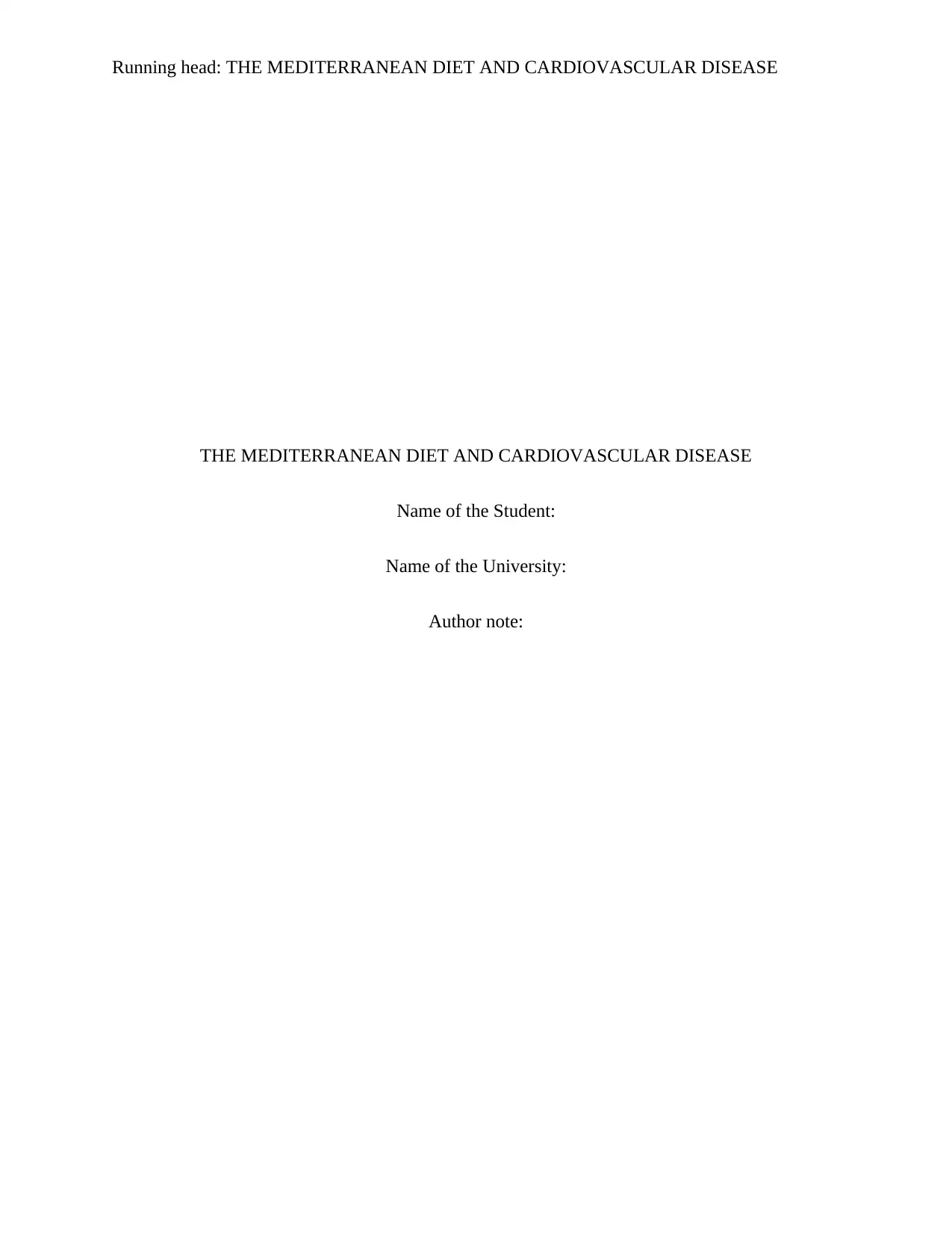
Running head: THE MEDITERRANEAN DIET AND CARDIOVASCULAR DISEASE
THE MEDITERRANEAN DIET AND CARDIOVASCULAR DISEASE
Name of the Student:
Name of the University:
Author note:
THE MEDITERRANEAN DIET AND CARDIOVASCULAR DISEASE
Name of the Student:
Name of the University:
Author note:
Secure Best Marks with AI Grader
Need help grading? Try our AI Grader for instant feedback on your assignments.
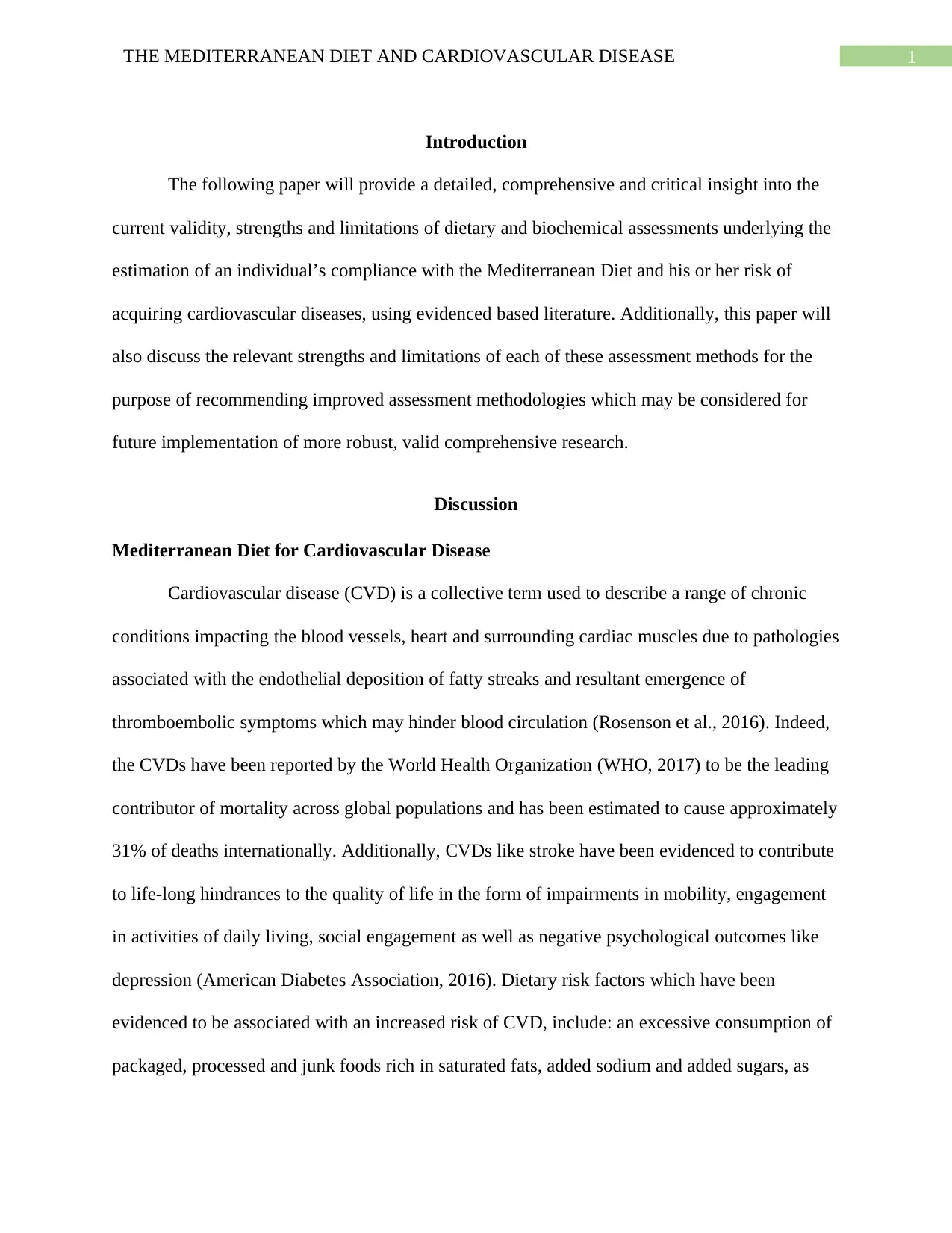
1THE MEDITERRANEAN DIET AND CARDIOVASCULAR DISEASE
Introduction
The following paper will provide a detailed, comprehensive and critical insight into the
current validity, strengths and limitations of dietary and biochemical assessments underlying the
estimation of an individual’s compliance with the Mediterranean Diet and his or her risk of
acquiring cardiovascular diseases, using evidenced based literature. Additionally, this paper will
also discuss the relevant strengths and limitations of each of these assessment methods for the
purpose of recommending improved assessment methodologies which may be considered for
future implementation of more robust, valid comprehensive research.
Discussion
Mediterranean Diet for Cardiovascular Disease
Cardiovascular disease (CVD) is a collective term used to describe a range of chronic
conditions impacting the blood vessels, heart and surrounding cardiac muscles due to pathologies
associated with the endothelial deposition of fatty streaks and resultant emergence of
thromboembolic symptoms which may hinder blood circulation (Rosenson et al., 2016). Indeed,
the CVDs have been reported by the World Health Organization (WHO, 2017) to be the leading
contributor of mortality across global populations and has been estimated to cause approximately
31% of deaths internationally. Additionally, CVDs like stroke have been evidenced to contribute
to life-long hindrances to the quality of life in the form of impairments in mobility, engagement
in activities of daily living, social engagement as well as negative psychological outcomes like
depression (American Diabetes Association, 2016). Dietary risk factors which have been
evidenced to be associated with an increased risk of CVD, include: an excessive consumption of
packaged, processed and junk foods rich in saturated fats, added sodium and added sugars, as
Introduction
The following paper will provide a detailed, comprehensive and critical insight into the
current validity, strengths and limitations of dietary and biochemical assessments underlying the
estimation of an individual’s compliance with the Mediterranean Diet and his or her risk of
acquiring cardiovascular diseases, using evidenced based literature. Additionally, this paper will
also discuss the relevant strengths and limitations of each of these assessment methods for the
purpose of recommending improved assessment methodologies which may be considered for
future implementation of more robust, valid comprehensive research.
Discussion
Mediterranean Diet for Cardiovascular Disease
Cardiovascular disease (CVD) is a collective term used to describe a range of chronic
conditions impacting the blood vessels, heart and surrounding cardiac muscles due to pathologies
associated with the endothelial deposition of fatty streaks and resultant emergence of
thromboembolic symptoms which may hinder blood circulation (Rosenson et al., 2016). Indeed,
the CVDs have been reported by the World Health Organization (WHO, 2017) to be the leading
contributor of mortality across global populations and has been estimated to cause approximately
31% of deaths internationally. Additionally, CVDs like stroke have been evidenced to contribute
to life-long hindrances to the quality of life in the form of impairments in mobility, engagement
in activities of daily living, social engagement as well as negative psychological outcomes like
depression (American Diabetes Association, 2016). Dietary risk factors which have been
evidenced to be associated with an increased risk of CVD, include: an excessive consumption of
packaged, processed and junk foods rich in saturated fats, added sodium and added sugars, as
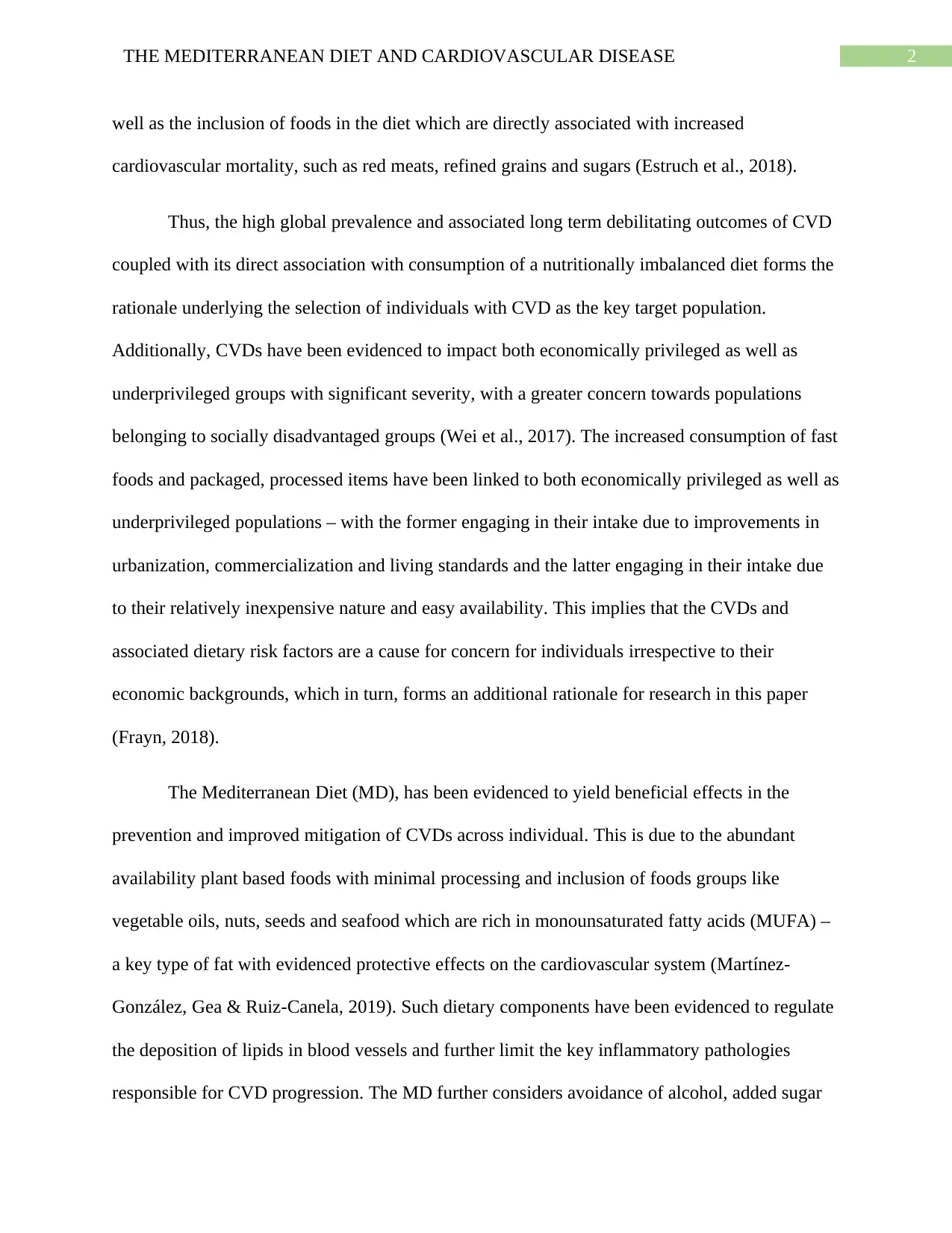
2THE MEDITERRANEAN DIET AND CARDIOVASCULAR DISEASE
well as the inclusion of foods in the diet which are directly associated with increased
cardiovascular mortality, such as red meats, refined grains and sugars (Estruch et al., 2018).
Thus, the high global prevalence and associated long term debilitating outcomes of CVD
coupled with its direct association with consumption of a nutritionally imbalanced diet forms the
rationale underlying the selection of individuals with CVD as the key target population.
Additionally, CVDs have been evidenced to impact both economically privileged as well as
underprivileged groups with significant severity, with a greater concern towards populations
belonging to socially disadvantaged groups (Wei et al., 2017). The increased consumption of fast
foods and packaged, processed items have been linked to both economically privileged as well as
underprivileged populations – with the former engaging in their intake due to improvements in
urbanization, commercialization and living standards and the latter engaging in their intake due
to their relatively inexpensive nature and easy availability. This implies that the CVDs and
associated dietary risk factors are a cause for concern for individuals irrespective to their
economic backgrounds, which in turn, forms an additional rationale for research in this paper
(Frayn, 2018).
The Mediterranean Diet (MD), has been evidenced to yield beneficial effects in the
prevention and improved mitigation of CVDs across individual. This is due to the abundant
availability plant based foods with minimal processing and inclusion of foods groups like
vegetable oils, nuts, seeds and seafood which are rich in monounsaturated fatty acids (MUFA) –
a key type of fat with evidenced protective effects on the cardiovascular system (Martínez-
González, Gea & Ruiz-Canela, 2019). Such dietary components have been evidenced to regulate
the deposition of lipids in blood vessels and further limit the key inflammatory pathologies
responsible for CVD progression. The MD further considers avoidance of alcohol, added sugar
well as the inclusion of foods in the diet which are directly associated with increased
cardiovascular mortality, such as red meats, refined grains and sugars (Estruch et al., 2018).
Thus, the high global prevalence and associated long term debilitating outcomes of CVD
coupled with its direct association with consumption of a nutritionally imbalanced diet forms the
rationale underlying the selection of individuals with CVD as the key target population.
Additionally, CVDs have been evidenced to impact both economically privileged as well as
underprivileged groups with significant severity, with a greater concern towards populations
belonging to socially disadvantaged groups (Wei et al., 2017). The increased consumption of fast
foods and packaged, processed items have been linked to both economically privileged as well as
underprivileged populations – with the former engaging in their intake due to improvements in
urbanization, commercialization and living standards and the latter engaging in their intake due
to their relatively inexpensive nature and easy availability. This implies that the CVDs and
associated dietary risk factors are a cause for concern for individuals irrespective to their
economic backgrounds, which in turn, forms an additional rationale for research in this paper
(Frayn, 2018).
The Mediterranean Diet (MD), has been evidenced to yield beneficial effects in the
prevention and improved mitigation of CVDs across individual. This is due to the abundant
availability plant based foods with minimal processing and inclusion of foods groups like
vegetable oils, nuts, seeds and seafood which are rich in monounsaturated fatty acids (MUFA) –
a key type of fat with evidenced protective effects on the cardiovascular system (Martínez-
González, Gea & Ruiz-Canela, 2019). Such dietary components have been evidenced to regulate
the deposition of lipids in blood vessels and further limit the key inflammatory pathologies
responsible for CVD progression. The MD further considers avoidance of alcohol, added sugar
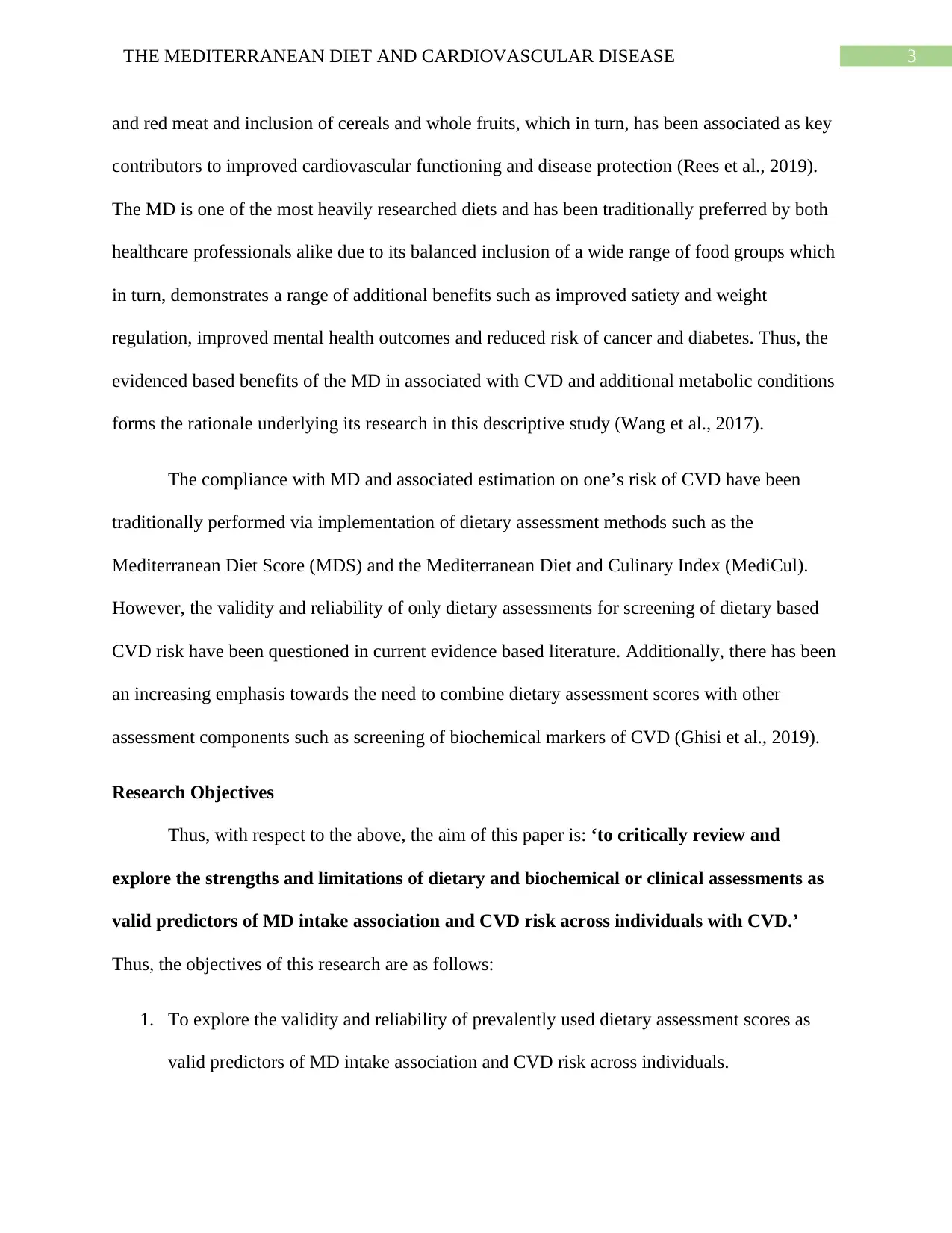
3THE MEDITERRANEAN DIET AND CARDIOVASCULAR DISEASE
and red meat and inclusion of cereals and whole fruits, which in turn, has been associated as key
contributors to improved cardiovascular functioning and disease protection (Rees et al., 2019).
The MD is one of the most heavily researched diets and has been traditionally preferred by both
healthcare professionals alike due to its balanced inclusion of a wide range of food groups which
in turn, demonstrates a range of additional benefits such as improved satiety and weight
regulation, improved mental health outcomes and reduced risk of cancer and diabetes. Thus, the
evidenced based benefits of the MD in associated with CVD and additional metabolic conditions
forms the rationale underlying its research in this descriptive study (Wang et al., 2017).
The compliance with MD and associated estimation on one’s risk of CVD have been
traditionally performed via implementation of dietary assessment methods such as the
Mediterranean Diet Score (MDS) and the Mediterranean Diet and Culinary Index (MediCul).
However, the validity and reliability of only dietary assessments for screening of dietary based
CVD risk have been questioned in current evidence based literature. Additionally, there has been
an increasing emphasis towards the need to combine dietary assessment scores with other
assessment components such as screening of biochemical markers of CVD (Ghisi et al., 2019).
Research Objectives
Thus, with respect to the above, the aim of this paper is: ‘to critically review and
explore the strengths and limitations of dietary and biochemical or clinical assessments as
valid predictors of MD intake association and CVD risk across individuals with CVD.’
Thus, the objectives of this research are as follows:
1. To explore the validity and reliability of prevalently used dietary assessment scores as
valid predictors of MD intake association and CVD risk across individuals.
and red meat and inclusion of cereals and whole fruits, which in turn, has been associated as key
contributors to improved cardiovascular functioning and disease protection (Rees et al., 2019).
The MD is one of the most heavily researched diets and has been traditionally preferred by both
healthcare professionals alike due to its balanced inclusion of a wide range of food groups which
in turn, demonstrates a range of additional benefits such as improved satiety and weight
regulation, improved mental health outcomes and reduced risk of cancer and diabetes. Thus, the
evidenced based benefits of the MD in associated with CVD and additional metabolic conditions
forms the rationale underlying its research in this descriptive study (Wang et al., 2017).
The compliance with MD and associated estimation on one’s risk of CVD have been
traditionally performed via implementation of dietary assessment methods such as the
Mediterranean Diet Score (MDS) and the Mediterranean Diet and Culinary Index (MediCul).
However, the validity and reliability of only dietary assessments for screening of dietary based
CVD risk have been questioned in current evidence based literature. Additionally, there has been
an increasing emphasis towards the need to combine dietary assessment scores with other
assessment components such as screening of biochemical markers of CVD (Ghisi et al., 2019).
Research Objectives
Thus, with respect to the above, the aim of this paper is: ‘to critically review and
explore the strengths and limitations of dietary and biochemical or clinical assessments as
valid predictors of MD intake association and CVD risk across individuals with CVD.’
Thus, the objectives of this research are as follows:
1. To explore the validity and reliability of prevalently used dietary assessment scores as
valid predictors of MD intake association and CVD risk across individuals.
Secure Best Marks with AI Grader
Need help grading? Try our AI Grader for instant feedback on your assignments.
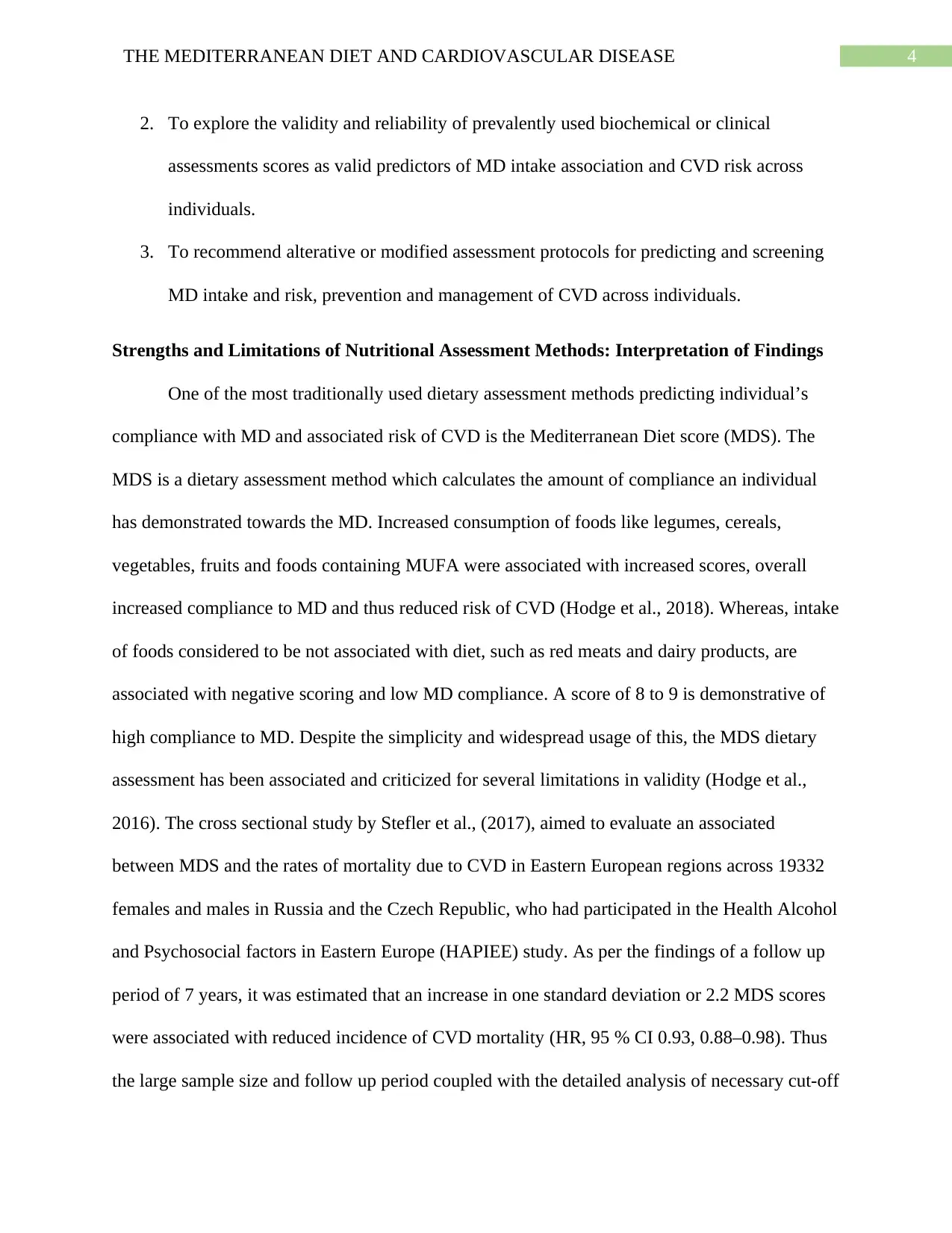
4THE MEDITERRANEAN DIET AND CARDIOVASCULAR DISEASE
2. To explore the validity and reliability of prevalently used biochemical or clinical
assessments scores as valid predictors of MD intake association and CVD risk across
individuals.
3. To recommend alterative or modified assessment protocols for predicting and screening
MD intake and risk, prevention and management of CVD across individuals.
Strengths and Limitations of Nutritional Assessment Methods: Interpretation of Findings
One of the most traditionally used dietary assessment methods predicting individual’s
compliance with MD and associated risk of CVD is the Mediterranean Diet score (MDS). The
MDS is a dietary assessment method which calculates the amount of compliance an individual
has demonstrated towards the MD. Increased consumption of foods like legumes, cereals,
vegetables, fruits and foods containing MUFA were associated with increased scores, overall
increased compliance to MD and thus reduced risk of CVD (Hodge et al., 2018). Whereas, intake
of foods considered to be not associated with diet, such as red meats and dairy products, are
associated with negative scoring and low MD compliance. A score of 8 to 9 is demonstrative of
high compliance to MD. Despite the simplicity and widespread usage of this, the MDS dietary
assessment has been associated and criticized for several limitations in validity (Hodge et al.,
2016). The cross sectional study by Stefler et al., (2017), aimed to evaluate an associated
between MDS and the rates of mortality due to CVD in Eastern European regions across 19332
females and males in Russia and the Czech Republic, who had participated in the Health Alcohol
and Psychosocial factors in Eastern Europe (HAPIEE) study. As per the findings of a follow up
period of 7 years, it was estimated that an increase in one standard deviation or 2.2 MDS scores
were associated with reduced incidence of CVD mortality (HR, 95 % CI 0.93, 0.88–0.98). Thus
the large sample size and follow up period coupled with the detailed analysis of necessary cut-off
2. To explore the validity and reliability of prevalently used biochemical or clinical
assessments scores as valid predictors of MD intake association and CVD risk across
individuals.
3. To recommend alterative or modified assessment protocols for predicting and screening
MD intake and risk, prevention and management of CVD across individuals.
Strengths and Limitations of Nutritional Assessment Methods: Interpretation of Findings
One of the most traditionally used dietary assessment methods predicting individual’s
compliance with MD and associated risk of CVD is the Mediterranean Diet score (MDS). The
MDS is a dietary assessment method which calculates the amount of compliance an individual
has demonstrated towards the MD. Increased consumption of foods like legumes, cereals,
vegetables, fruits and foods containing MUFA were associated with increased scores, overall
increased compliance to MD and thus reduced risk of CVD (Hodge et al., 2018). Whereas, intake
of foods considered to be not associated with diet, such as red meats and dairy products, are
associated with negative scoring and low MD compliance. A score of 8 to 9 is demonstrative of
high compliance to MD. Despite the simplicity and widespread usage of this, the MDS dietary
assessment has been associated and criticized for several limitations in validity (Hodge et al.,
2016). The cross sectional study by Stefler et al., (2017), aimed to evaluate an associated
between MDS and the rates of mortality due to CVD in Eastern European regions across 19332
females and males in Russia and the Czech Republic, who had participated in the Health Alcohol
and Psychosocial factors in Eastern Europe (HAPIEE) study. As per the findings of a follow up
period of 7 years, it was estimated that an increase in one standard deviation or 2.2 MDS scores
were associated with reduced incidence of CVD mortality (HR, 95 % CI 0.93, 0.88–0.98). Thus
the large sample size and follow up period coupled with the detailed analysis of necessary cut-off
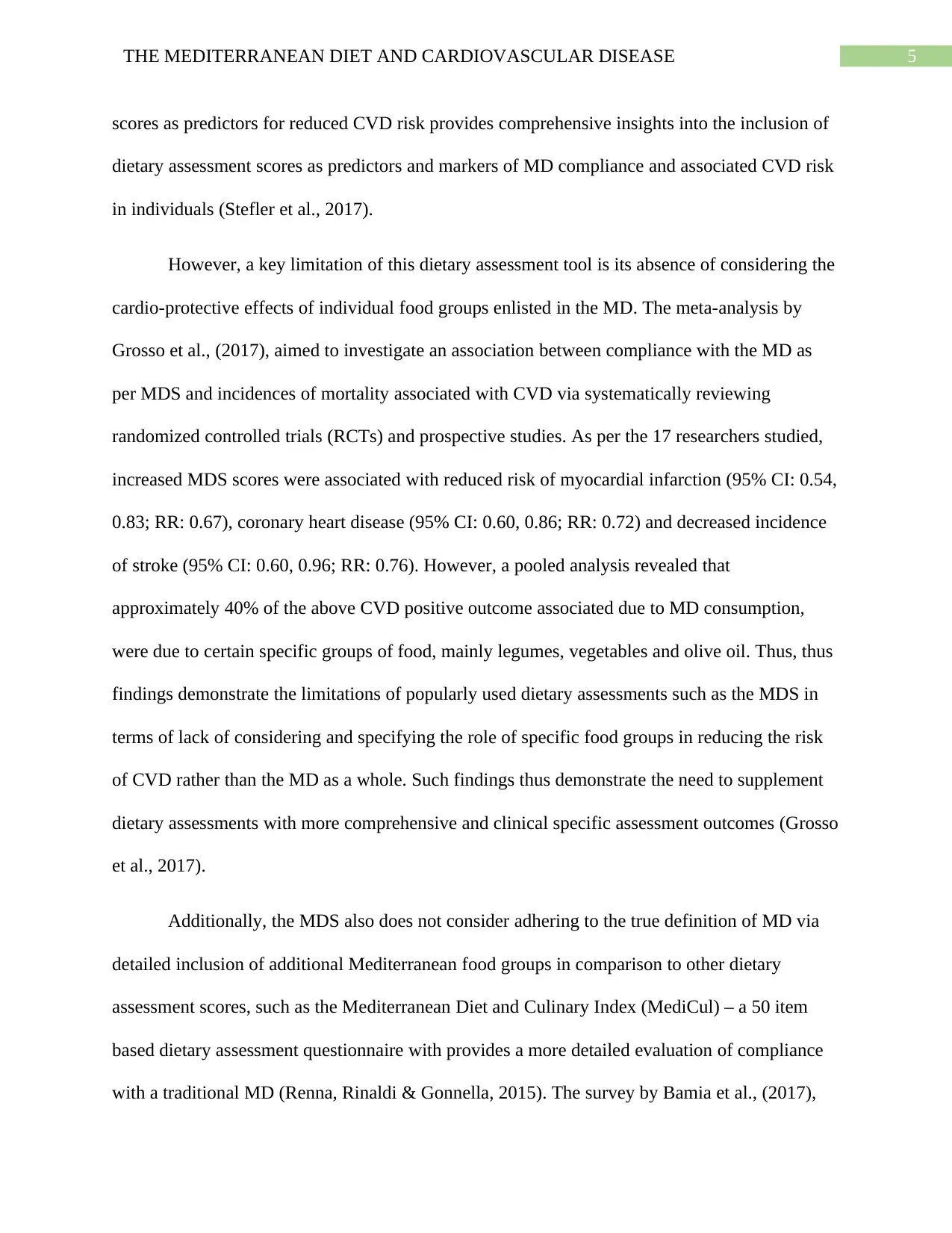
5THE MEDITERRANEAN DIET AND CARDIOVASCULAR DISEASE
scores as predictors for reduced CVD risk provides comprehensive insights into the inclusion of
dietary assessment scores as predictors and markers of MD compliance and associated CVD risk
in individuals (Stefler et al., 2017).
However, a key limitation of this dietary assessment tool is its absence of considering the
cardio-protective effects of individual food groups enlisted in the MD. The meta-analysis by
Grosso et al., (2017), aimed to investigate an association between compliance with the MD as
per MDS and incidences of mortality associated with CVD via systematically reviewing
randomized controlled trials (RCTs) and prospective studies. As per the 17 researchers studied,
increased MDS scores were associated with reduced risk of myocardial infarction (95% CI: 0.54,
0.83; RR: 0.67), coronary heart disease (95% CI: 0.60, 0.86; RR: 0.72) and decreased incidence
of stroke (95% CI: 0.60, 0.96; RR: 0.76). However, a pooled analysis revealed that
approximately 40% of the above CVD positive outcome associated due to MD consumption,
were due to certain specific groups of food, mainly legumes, vegetables and olive oil. Thus, thus
findings demonstrate the limitations of popularly used dietary assessments such as the MDS in
terms of lack of considering and specifying the role of specific food groups in reducing the risk
of CVD rather than the MD as a whole. Such findings thus demonstrate the need to supplement
dietary assessments with more comprehensive and clinical specific assessment outcomes (Grosso
et al., 2017).
Additionally, the MDS also does not consider adhering to the true definition of MD via
detailed inclusion of additional Mediterranean food groups in comparison to other dietary
assessment scores, such as the Mediterranean Diet and Culinary Index (MediCul) – a 50 item
based dietary assessment questionnaire with provides a more detailed evaluation of compliance
with a traditional MD (Renna, Rinaldi & Gonnella, 2015). The survey by Bamia et al., (2017),
scores as predictors for reduced CVD risk provides comprehensive insights into the inclusion of
dietary assessment scores as predictors and markers of MD compliance and associated CVD risk
in individuals (Stefler et al., 2017).
However, a key limitation of this dietary assessment tool is its absence of considering the
cardio-protective effects of individual food groups enlisted in the MD. The meta-analysis by
Grosso et al., (2017), aimed to investigate an association between compliance with the MD as
per MDS and incidences of mortality associated with CVD via systematically reviewing
randomized controlled trials (RCTs) and prospective studies. As per the 17 researchers studied,
increased MDS scores were associated with reduced risk of myocardial infarction (95% CI: 0.54,
0.83; RR: 0.67), coronary heart disease (95% CI: 0.60, 0.86; RR: 0.72) and decreased incidence
of stroke (95% CI: 0.60, 0.96; RR: 0.76). However, a pooled analysis revealed that
approximately 40% of the above CVD positive outcome associated due to MD consumption,
were due to certain specific groups of food, mainly legumes, vegetables and olive oil. Thus, thus
findings demonstrate the limitations of popularly used dietary assessments such as the MDS in
terms of lack of considering and specifying the role of specific food groups in reducing the risk
of CVD rather than the MD as a whole. Such findings thus demonstrate the need to supplement
dietary assessments with more comprehensive and clinical specific assessment outcomes (Grosso
et al., 2017).
Additionally, the MDS also does not consider adhering to the true definition of MD via
detailed inclusion of additional Mediterranean food groups in comparison to other dietary
assessment scores, such as the Mediterranean Diet and Culinary Index (MediCul) – a 50 item
based dietary assessment questionnaire with provides a more detailed evaluation of compliance
with a traditional MD (Renna, Rinaldi & Gonnella, 2015). The survey by Bamia et al., (2017),
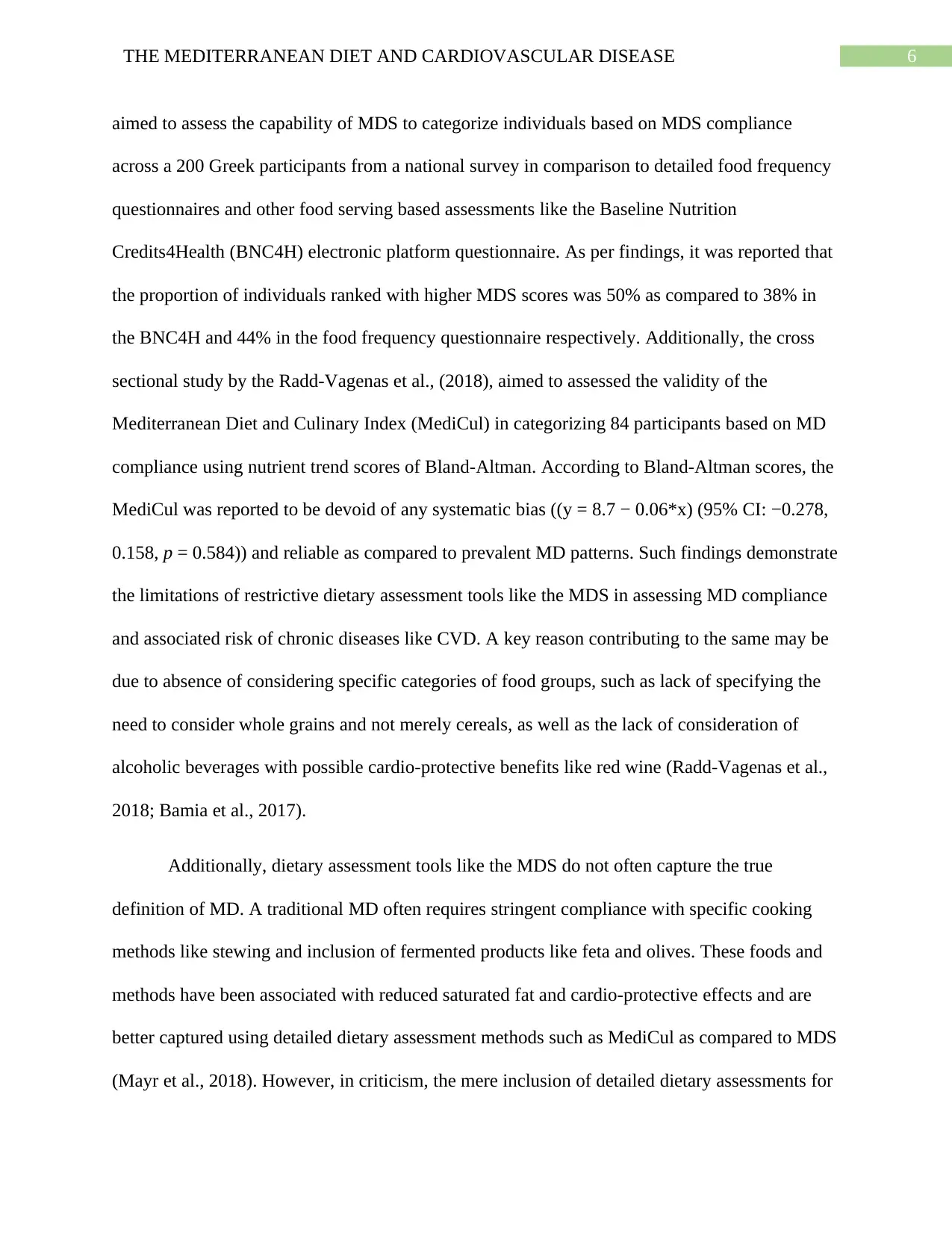
6THE MEDITERRANEAN DIET AND CARDIOVASCULAR DISEASE
aimed to assess the capability of MDS to categorize individuals based on MDS compliance
across a 200 Greek participants from a national survey in comparison to detailed food frequency
questionnaires and other food serving based assessments like the Baseline Nutrition
Credits4Health (BNC4H) electronic platform questionnaire. As per findings, it was reported that
the proportion of individuals ranked with higher MDS scores was 50% as compared to 38% in
the BNC4H and 44% in the food frequency questionnaire respectively. Additionally, the cross
sectional study by the Radd-Vagenas et al., (2018), aimed to assessed the validity of the
Mediterranean Diet and Culinary Index (MediCul) in categorizing 84 participants based on MD
compliance using nutrient trend scores of Bland-Altman. According to Bland-Altman scores, the
MediCul was reported to be devoid of any systematic bias ((y = 8.7 − 0.06*x) (95% CI: −0.278,
0.158, p = 0.584)) and reliable as compared to prevalent MD patterns. Such findings demonstrate
the limitations of restrictive dietary assessment tools like the MDS in assessing MD compliance
and associated risk of chronic diseases like CVD. A key reason contributing to the same may be
due to absence of considering specific categories of food groups, such as lack of specifying the
need to consider whole grains and not merely cereals, as well as the lack of consideration of
alcoholic beverages with possible cardio-protective benefits like red wine (Radd-Vagenas et al.,
2018; Bamia et al., 2017).
Additionally, dietary assessment tools like the MDS do not often capture the true
definition of MD. A traditional MD often requires stringent compliance with specific cooking
methods like stewing and inclusion of fermented products like feta and olives. These foods and
methods have been associated with reduced saturated fat and cardio-protective effects and are
better captured using detailed dietary assessment methods such as MediCul as compared to MDS
(Mayr et al., 2018). However, in criticism, the mere inclusion of detailed dietary assessments for
aimed to assess the capability of MDS to categorize individuals based on MDS compliance
across a 200 Greek participants from a national survey in comparison to detailed food frequency
questionnaires and other food serving based assessments like the Baseline Nutrition
Credits4Health (BNC4H) electronic platform questionnaire. As per findings, it was reported that
the proportion of individuals ranked with higher MDS scores was 50% as compared to 38% in
the BNC4H and 44% in the food frequency questionnaire respectively. Additionally, the cross
sectional study by the Radd-Vagenas et al., (2018), aimed to assessed the validity of the
Mediterranean Diet and Culinary Index (MediCul) in categorizing 84 participants based on MD
compliance using nutrient trend scores of Bland-Altman. According to Bland-Altman scores, the
MediCul was reported to be devoid of any systematic bias ((y = 8.7 − 0.06*x) (95% CI: −0.278,
0.158, p = 0.584)) and reliable as compared to prevalent MD patterns. Such findings demonstrate
the limitations of restrictive dietary assessment tools like the MDS in assessing MD compliance
and associated risk of chronic diseases like CVD. A key reason contributing to the same may be
due to absence of considering specific categories of food groups, such as lack of specifying the
need to consider whole grains and not merely cereals, as well as the lack of consideration of
alcoholic beverages with possible cardio-protective benefits like red wine (Radd-Vagenas et al.,
2018; Bamia et al., 2017).
Additionally, dietary assessment tools like the MDS do not often capture the true
definition of MD. A traditional MD often requires stringent compliance with specific cooking
methods like stewing and inclusion of fermented products like feta and olives. These foods and
methods have been associated with reduced saturated fat and cardio-protective effects and are
better captured using detailed dietary assessment methods such as MediCul as compared to MDS
(Mayr et al., 2018). However, in criticism, the mere inclusion of detailed dietary assessments for
Paraphrase This Document
Need a fresh take? Get an instant paraphrase of this document with our AI Paraphraser
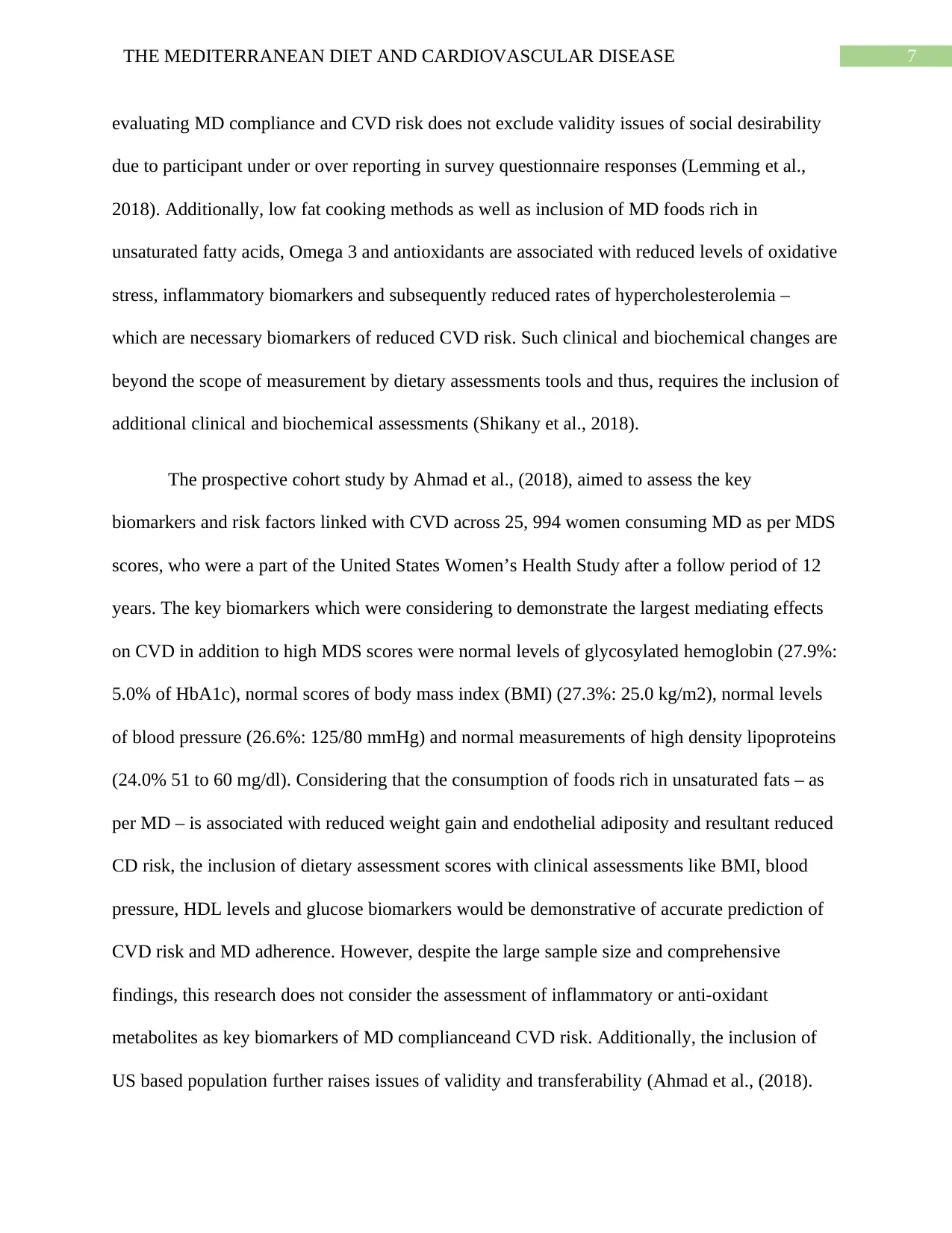
7THE MEDITERRANEAN DIET AND CARDIOVASCULAR DISEASE
evaluating MD compliance and CVD risk does not exclude validity issues of social desirability
due to participant under or over reporting in survey questionnaire responses (Lemming et al.,
2018). Additionally, low fat cooking methods as well as inclusion of MD foods rich in
unsaturated fatty acids, Omega 3 and antioxidants are associated with reduced levels of oxidative
stress, inflammatory biomarkers and subsequently reduced rates of hypercholesterolemia –
which are necessary biomarkers of reduced CVD risk. Such clinical and biochemical changes are
beyond the scope of measurement by dietary assessments tools and thus, requires the inclusion of
additional clinical and biochemical assessments (Shikany et al., 2018).
The prospective cohort study by Ahmad et al., (2018), aimed to assess the key
biomarkers and risk factors linked with CVD across 25, 994 women consuming MD as per MDS
scores, who were a part of the United States Women’s Health Study after a follow period of 12
years. The key biomarkers which were considering to demonstrate the largest mediating effects
on CVD in addition to high MDS scores were normal levels of glycosylated hemoglobin (27.9%:
5.0% of HbA1c), normal scores of body mass index (BMI) (27.3%: 25.0 kg/m2), normal levels
of blood pressure (26.6%: 125/80 mmHg) and normal measurements of high density lipoproteins
(24.0% 51 to 60 mg/dl). Considering that the consumption of foods rich in unsaturated fats – as
per MD – is associated with reduced weight gain and endothelial adiposity and resultant reduced
CD risk, the inclusion of dietary assessment scores with clinical assessments like BMI, blood
pressure, HDL levels and glucose biomarkers would be demonstrative of accurate prediction of
CVD risk and MD adherence. However, despite the large sample size and comprehensive
findings, this research does not consider the assessment of inflammatory or anti-oxidant
metabolites as key biomarkers of MD complianceand CVD risk. Additionally, the inclusion of
US based population further raises issues of validity and transferability (Ahmad et al., (2018).
evaluating MD compliance and CVD risk does not exclude validity issues of social desirability
due to participant under or over reporting in survey questionnaire responses (Lemming et al.,
2018). Additionally, low fat cooking methods as well as inclusion of MD foods rich in
unsaturated fatty acids, Omega 3 and antioxidants are associated with reduced levels of oxidative
stress, inflammatory biomarkers and subsequently reduced rates of hypercholesterolemia –
which are necessary biomarkers of reduced CVD risk. Such clinical and biochemical changes are
beyond the scope of measurement by dietary assessments tools and thus, requires the inclusion of
additional clinical and biochemical assessments (Shikany et al., 2018).
The prospective cohort study by Ahmad et al., (2018), aimed to assess the key
biomarkers and risk factors linked with CVD across 25, 994 women consuming MD as per MDS
scores, who were a part of the United States Women’s Health Study after a follow period of 12
years. The key biomarkers which were considering to demonstrate the largest mediating effects
on CVD in addition to high MDS scores were normal levels of glycosylated hemoglobin (27.9%:
5.0% of HbA1c), normal scores of body mass index (BMI) (27.3%: 25.0 kg/m2), normal levels
of blood pressure (26.6%: 125/80 mmHg) and normal measurements of high density lipoproteins
(24.0% 51 to 60 mg/dl). Considering that the consumption of foods rich in unsaturated fats – as
per MD – is associated with reduced weight gain and endothelial adiposity and resultant reduced
CD risk, the inclusion of dietary assessment scores with clinical assessments like BMI, blood
pressure, HDL levels and glucose biomarkers would be demonstrative of accurate prediction of
CVD risk and MD adherence. However, despite the large sample size and comprehensive
findings, this research does not consider the assessment of inflammatory or anti-oxidant
metabolites as key biomarkers of MD complianceand CVD risk. Additionally, the inclusion of
US based population further raises issues of validity and transferability (Ahmad et al., (2018).
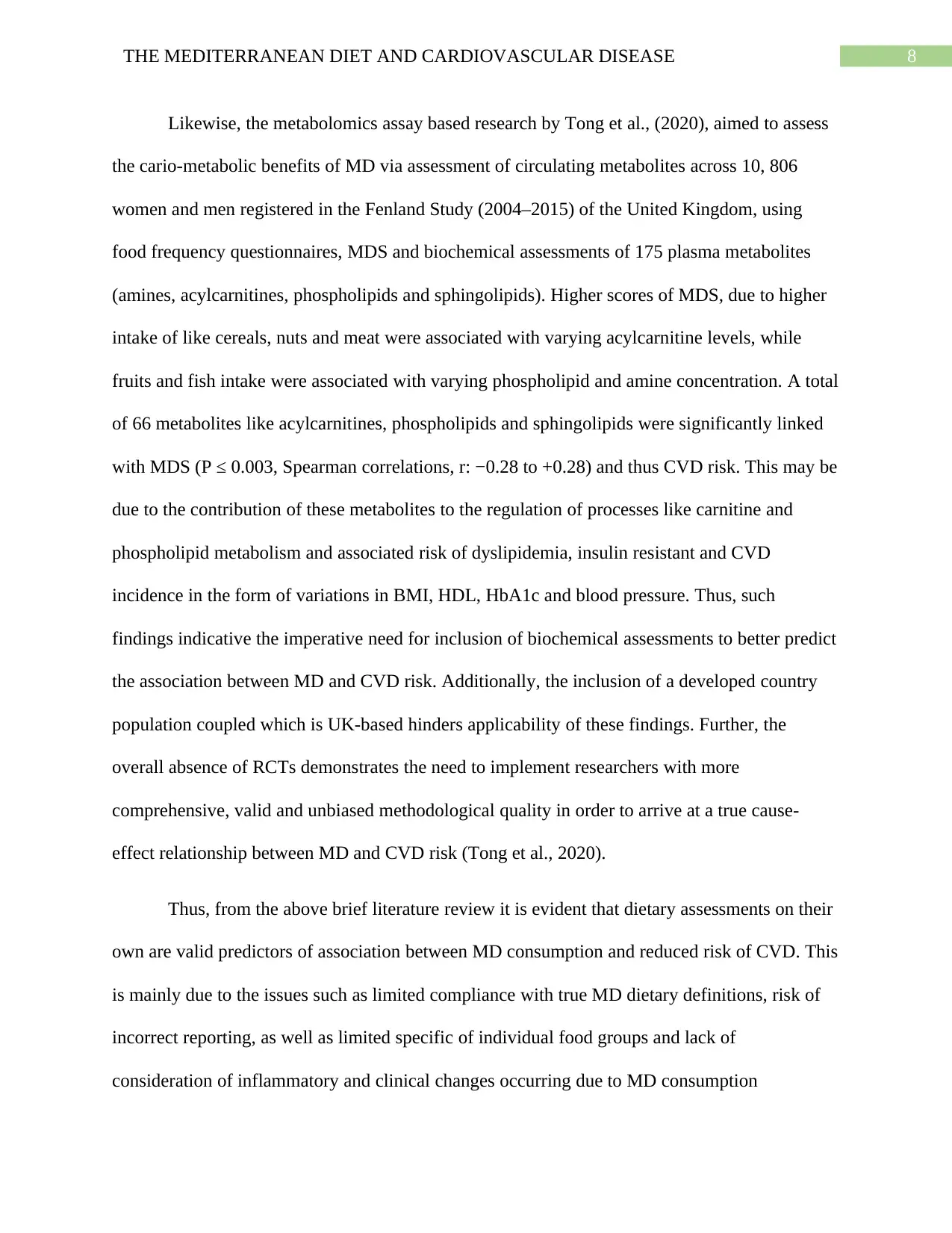
8THE MEDITERRANEAN DIET AND CARDIOVASCULAR DISEASE
Likewise, the metabolomics assay based research by Tong et al., (2020), aimed to assess
the cario-metabolic benefits of MD via assessment of circulating metabolites across 10, 806
women and men registered in the Fenland Study (2004–2015) of the United Kingdom, using
food frequency questionnaires, MDS and biochemical assessments of 175 plasma metabolites
(amines, acylcarnitines, phospholipids and sphingolipids). Higher scores of MDS, due to higher
intake of like cereals, nuts and meat were associated with varying acylcarnitine levels, while
fruits and fish intake were associated with varying phospholipid and amine concentration. A total
of 66 metabolites like acylcarnitines, phospholipids and sphingolipids were significantly linked
with MDS (P ≤ 0.003, Spearman correlations, r: −0.28 to +0.28) and thus CVD risk. This may be
due to the contribution of these metabolites to the regulation of processes like carnitine and
phospholipid metabolism and associated risk of dyslipidemia, insulin resistant and CVD
incidence in the form of variations in BMI, HDL, HbA1c and blood pressure. Thus, such
findings indicative the imperative need for inclusion of biochemical assessments to better predict
the association between MD and CVD risk. Additionally, the inclusion of a developed country
population coupled which is UK-based hinders applicability of these findings. Further, the
overall absence of RCTs demonstrates the need to implement researchers with more
comprehensive, valid and unbiased methodological quality in order to arrive at a true cause-
effect relationship between MD and CVD risk (Tong et al., 2020).
Thus, from the above brief literature review it is evident that dietary assessments on their
own are valid predictors of association between MD consumption and reduced risk of CVD. This
is mainly due to the issues such as limited compliance with true MD dietary definitions, risk of
incorrect reporting, as well as limited specific of individual food groups and lack of
consideration of inflammatory and clinical changes occurring due to MD consumption
Likewise, the metabolomics assay based research by Tong et al., (2020), aimed to assess
the cario-metabolic benefits of MD via assessment of circulating metabolites across 10, 806
women and men registered in the Fenland Study (2004–2015) of the United Kingdom, using
food frequency questionnaires, MDS and biochemical assessments of 175 plasma metabolites
(amines, acylcarnitines, phospholipids and sphingolipids). Higher scores of MDS, due to higher
intake of like cereals, nuts and meat were associated with varying acylcarnitine levels, while
fruits and fish intake were associated with varying phospholipid and amine concentration. A total
of 66 metabolites like acylcarnitines, phospholipids and sphingolipids were significantly linked
with MDS (P ≤ 0.003, Spearman correlations, r: −0.28 to +0.28) and thus CVD risk. This may be
due to the contribution of these metabolites to the regulation of processes like carnitine and
phospholipid metabolism and associated risk of dyslipidemia, insulin resistant and CVD
incidence in the form of variations in BMI, HDL, HbA1c and blood pressure. Thus, such
findings indicative the imperative need for inclusion of biochemical assessments to better predict
the association between MD and CVD risk. Additionally, the inclusion of a developed country
population coupled which is UK-based hinders applicability of these findings. Further, the
overall absence of RCTs demonstrates the need to implement researchers with more
comprehensive, valid and unbiased methodological quality in order to arrive at a true cause-
effect relationship between MD and CVD risk (Tong et al., 2020).
Thus, from the above brief literature review it is evident that dietary assessments on their
own are valid predictors of association between MD consumption and reduced risk of CVD. This
is mainly due to the issues such as limited compliance with true MD dietary definitions, risk of
incorrect reporting, as well as limited specific of individual food groups and lack of
consideration of inflammatory and clinical changes occurring due to MD consumption
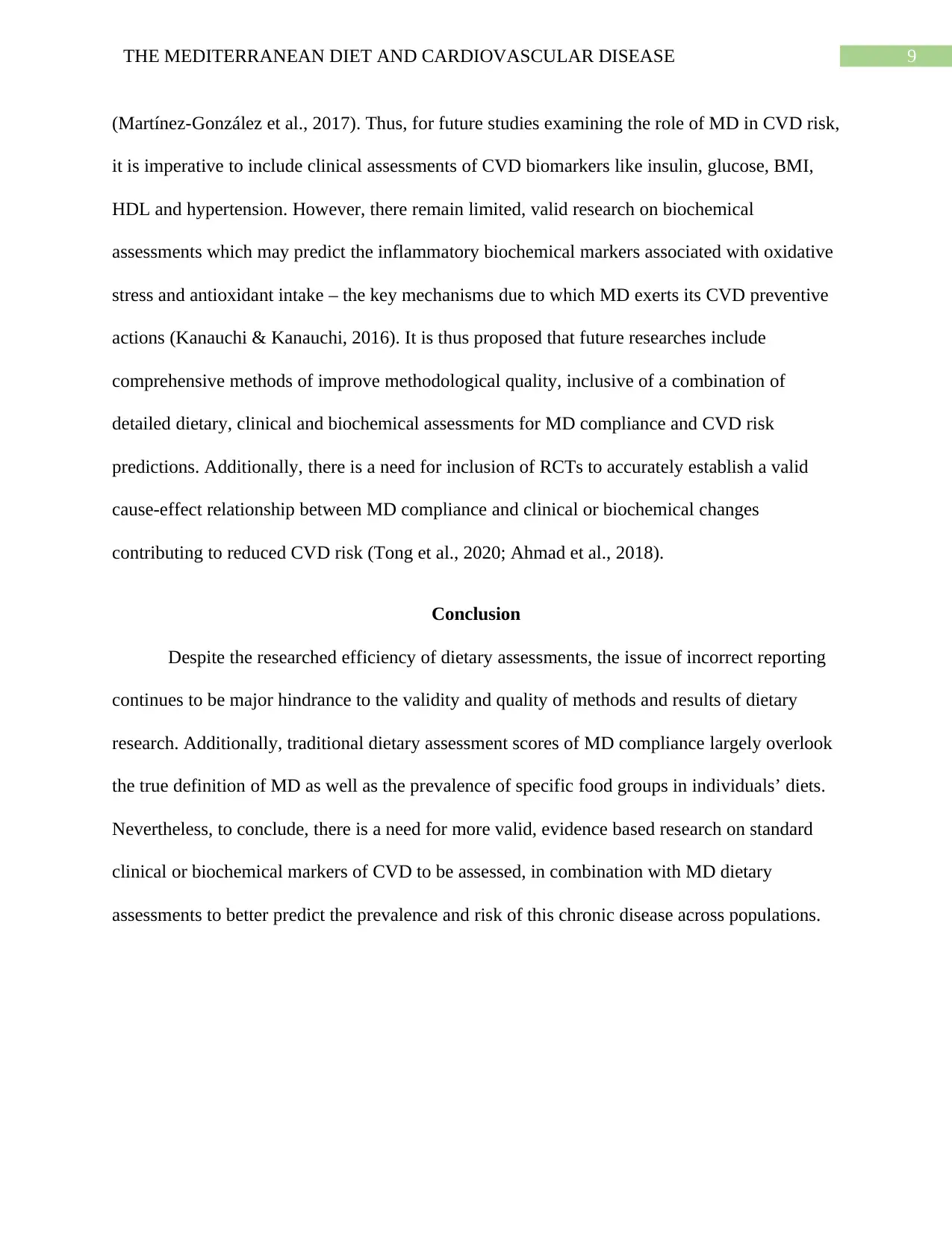
9THE MEDITERRANEAN DIET AND CARDIOVASCULAR DISEASE
(Martínez-González et al., 2017). Thus, for future studies examining the role of MD in CVD risk,
it is imperative to include clinical assessments of CVD biomarkers like insulin, glucose, BMI,
HDL and hypertension. However, there remain limited, valid research on biochemical
assessments which may predict the inflammatory biochemical markers associated with oxidative
stress and antioxidant intake – the key mechanisms due to which MD exerts its CVD preventive
actions (Kanauchi & Kanauchi, 2016). It is thus proposed that future researches include
comprehensive methods of improve methodological quality, inclusive of a combination of
detailed dietary, clinical and biochemical assessments for MD compliance and CVD risk
predictions. Additionally, there is a need for inclusion of RCTs to accurately establish a valid
cause-effect relationship between MD compliance and clinical or biochemical changes
contributing to reduced CVD risk (Tong et al., 2020; Ahmad et al., 2018).
Conclusion
Despite the researched efficiency of dietary assessments, the issue of incorrect reporting
continues to be major hindrance to the validity and quality of methods and results of dietary
research. Additionally, traditional dietary assessment scores of MD compliance largely overlook
the true definition of MD as well as the prevalence of specific food groups in individuals’ diets.
Nevertheless, to conclude, there is a need for more valid, evidence based research on standard
clinical or biochemical markers of CVD to be assessed, in combination with MD dietary
assessments to better predict the prevalence and risk of this chronic disease across populations.
(Martínez-González et al., 2017). Thus, for future studies examining the role of MD in CVD risk,
it is imperative to include clinical assessments of CVD biomarkers like insulin, glucose, BMI,
HDL and hypertension. However, there remain limited, valid research on biochemical
assessments which may predict the inflammatory biochemical markers associated with oxidative
stress and antioxidant intake – the key mechanisms due to which MD exerts its CVD preventive
actions (Kanauchi & Kanauchi, 2016). It is thus proposed that future researches include
comprehensive methods of improve methodological quality, inclusive of a combination of
detailed dietary, clinical and biochemical assessments for MD compliance and CVD risk
predictions. Additionally, there is a need for inclusion of RCTs to accurately establish a valid
cause-effect relationship between MD compliance and clinical or biochemical changes
contributing to reduced CVD risk (Tong et al., 2020; Ahmad et al., 2018).
Conclusion
Despite the researched efficiency of dietary assessments, the issue of incorrect reporting
continues to be major hindrance to the validity and quality of methods and results of dietary
research. Additionally, traditional dietary assessment scores of MD compliance largely overlook
the true definition of MD as well as the prevalence of specific food groups in individuals’ diets.
Nevertheless, to conclude, there is a need for more valid, evidence based research on standard
clinical or biochemical markers of CVD to be assessed, in combination with MD dietary
assessments to better predict the prevalence and risk of this chronic disease across populations.
Secure Best Marks with AI Grader
Need help grading? Try our AI Grader for instant feedback on your assignments.
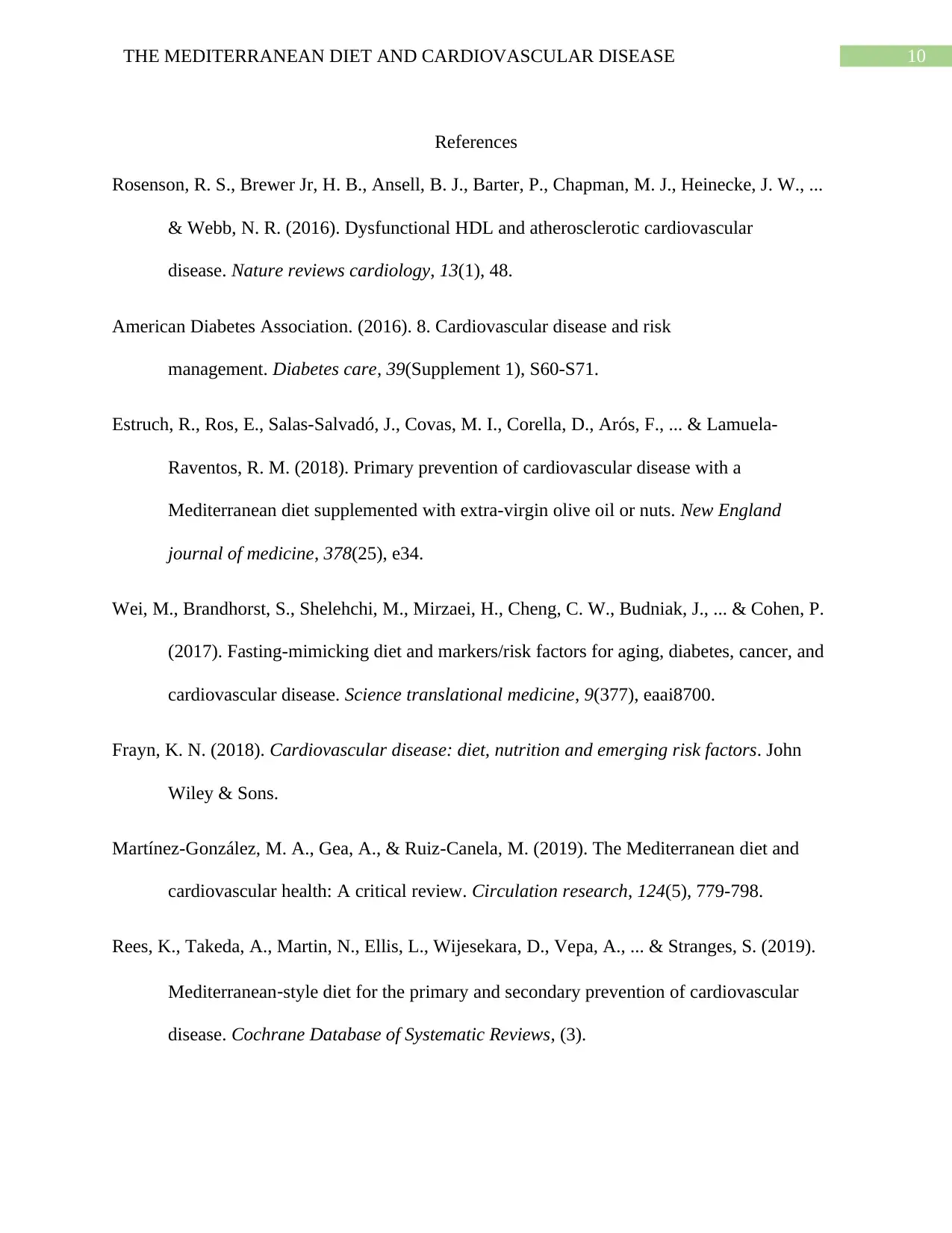
10THE MEDITERRANEAN DIET AND CARDIOVASCULAR DISEASE
References
Rosenson, R. S., Brewer Jr, H. B., Ansell, B. J., Barter, P., Chapman, M. J., Heinecke, J. W., ...
& Webb, N. R. (2016). Dysfunctional HDL and atherosclerotic cardiovascular
disease. Nature reviews cardiology, 13(1), 48.
American Diabetes Association. (2016). 8. Cardiovascular disease and risk
management. Diabetes care, 39(Supplement 1), S60-S71.
Estruch, R., Ros, E., Salas-Salvadó, J., Covas, M. I., Corella, D., Arós, F., ... & Lamuela-
Raventos, R. M. (2018). Primary prevention of cardiovascular disease with a
Mediterranean diet supplemented with extra-virgin olive oil or nuts. New England
journal of medicine, 378(25), e34.
Wei, M., Brandhorst, S., Shelehchi, M., Mirzaei, H., Cheng, C. W., Budniak, J., ... & Cohen, P.
(2017). Fasting-mimicking diet and markers/risk factors for aging, diabetes, cancer, and
cardiovascular disease. Science translational medicine, 9(377), eaai8700.
Frayn, K. N. (2018). Cardiovascular disease: diet, nutrition and emerging risk factors. John
Wiley & Sons.
Martínez-González, M. A., Gea, A., & Ruiz-Canela, M. (2019). The Mediterranean diet and
cardiovascular health: A critical review. Circulation research, 124(5), 779-798.
Rees, K., Takeda, A., Martin, N., Ellis, L., Wijesekara, D., Vepa, A., ... & Stranges, S. (2019).
Mediterranean‐style diet for the primary and secondary prevention of cardiovascular
disease. Cochrane Database of Systematic Reviews, (3).
References
Rosenson, R. S., Brewer Jr, H. B., Ansell, B. J., Barter, P., Chapman, M. J., Heinecke, J. W., ...
& Webb, N. R. (2016). Dysfunctional HDL and atherosclerotic cardiovascular
disease. Nature reviews cardiology, 13(1), 48.
American Diabetes Association. (2016). 8. Cardiovascular disease and risk
management. Diabetes care, 39(Supplement 1), S60-S71.
Estruch, R., Ros, E., Salas-Salvadó, J., Covas, M. I., Corella, D., Arós, F., ... & Lamuela-
Raventos, R. M. (2018). Primary prevention of cardiovascular disease with a
Mediterranean diet supplemented with extra-virgin olive oil or nuts. New England
journal of medicine, 378(25), e34.
Wei, M., Brandhorst, S., Shelehchi, M., Mirzaei, H., Cheng, C. W., Budniak, J., ... & Cohen, P.
(2017). Fasting-mimicking diet and markers/risk factors for aging, diabetes, cancer, and
cardiovascular disease. Science translational medicine, 9(377), eaai8700.
Frayn, K. N. (2018). Cardiovascular disease: diet, nutrition and emerging risk factors. John
Wiley & Sons.
Martínez-González, M. A., Gea, A., & Ruiz-Canela, M. (2019). The Mediterranean diet and
cardiovascular health: A critical review. Circulation research, 124(5), 779-798.
Rees, K., Takeda, A., Martin, N., Ellis, L., Wijesekara, D., Vepa, A., ... & Stranges, S. (2019).
Mediterranean‐style diet for the primary and secondary prevention of cardiovascular
disease. Cochrane Database of Systematic Reviews, (3).
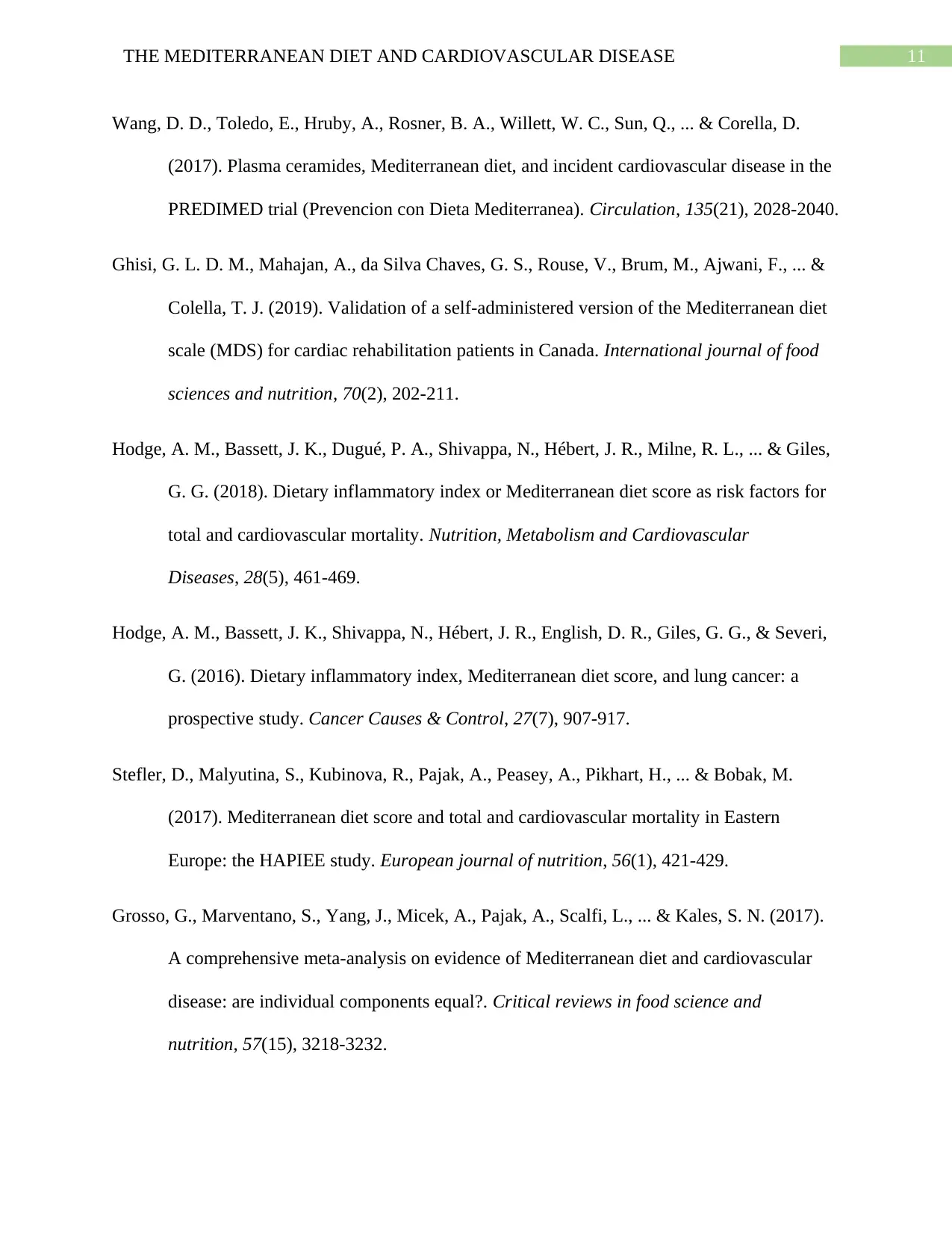
11THE MEDITERRANEAN DIET AND CARDIOVASCULAR DISEASE
Wang, D. D., Toledo, E., Hruby, A., Rosner, B. A., Willett, W. C., Sun, Q., ... & Corella, D.
(2017). Plasma ceramides, Mediterranean diet, and incident cardiovascular disease in the
PREDIMED trial (Prevencion con Dieta Mediterranea). Circulation, 135(21), 2028-2040.
Ghisi, G. L. D. M., Mahajan, A., da Silva Chaves, G. S., Rouse, V., Brum, M., Ajwani, F., ... &
Colella, T. J. (2019). Validation of a self-administered version of the Mediterranean diet
scale (MDS) for cardiac rehabilitation patients in Canada. International journal of food
sciences and nutrition, 70(2), 202-211.
Hodge, A. M., Bassett, J. K., Dugué, P. A., Shivappa, N., Hébert, J. R., Milne, R. L., ... & Giles,
G. G. (2018). Dietary inflammatory index or Mediterranean diet score as risk factors for
total and cardiovascular mortality. Nutrition, Metabolism and Cardiovascular
Diseases, 28(5), 461-469.
Hodge, A. M., Bassett, J. K., Shivappa, N., Hébert, J. R., English, D. R., Giles, G. G., & Severi,
G. (2016). Dietary inflammatory index, Mediterranean diet score, and lung cancer: a
prospective study. Cancer Causes & Control, 27(7), 907-917.
Stefler, D., Malyutina, S., Kubinova, R., Pajak, A., Peasey, A., Pikhart, H., ... & Bobak, M.
(2017). Mediterranean diet score and total and cardiovascular mortality in Eastern
Europe: the HAPIEE study. European journal of nutrition, 56(1), 421-429.
Grosso, G., Marventano, S., Yang, J., Micek, A., Pajak, A., Scalfi, L., ... & Kales, S. N. (2017).
A comprehensive meta-analysis on evidence of Mediterranean diet and cardiovascular
disease: are individual components equal?. Critical reviews in food science and
nutrition, 57(15), 3218-3232.
Wang, D. D., Toledo, E., Hruby, A., Rosner, B. A., Willett, W. C., Sun, Q., ... & Corella, D.
(2017). Plasma ceramides, Mediterranean diet, and incident cardiovascular disease in the
PREDIMED trial (Prevencion con Dieta Mediterranea). Circulation, 135(21), 2028-2040.
Ghisi, G. L. D. M., Mahajan, A., da Silva Chaves, G. S., Rouse, V., Brum, M., Ajwani, F., ... &
Colella, T. J. (2019). Validation of a self-administered version of the Mediterranean diet
scale (MDS) for cardiac rehabilitation patients in Canada. International journal of food
sciences and nutrition, 70(2), 202-211.
Hodge, A. M., Bassett, J. K., Dugué, P. A., Shivappa, N., Hébert, J. R., Milne, R. L., ... & Giles,
G. G. (2018). Dietary inflammatory index or Mediterranean diet score as risk factors for
total and cardiovascular mortality. Nutrition, Metabolism and Cardiovascular
Diseases, 28(5), 461-469.
Hodge, A. M., Bassett, J. K., Shivappa, N., Hébert, J. R., English, D. R., Giles, G. G., & Severi,
G. (2016). Dietary inflammatory index, Mediterranean diet score, and lung cancer: a
prospective study. Cancer Causes & Control, 27(7), 907-917.
Stefler, D., Malyutina, S., Kubinova, R., Pajak, A., Peasey, A., Pikhart, H., ... & Bobak, M.
(2017). Mediterranean diet score and total and cardiovascular mortality in Eastern
Europe: the HAPIEE study. European journal of nutrition, 56(1), 421-429.
Grosso, G., Marventano, S., Yang, J., Micek, A., Pajak, A., Scalfi, L., ... & Kales, S. N. (2017).
A comprehensive meta-analysis on evidence of Mediterranean diet and cardiovascular
disease: are individual components equal?. Critical reviews in food science and
nutrition, 57(15), 3218-3232.
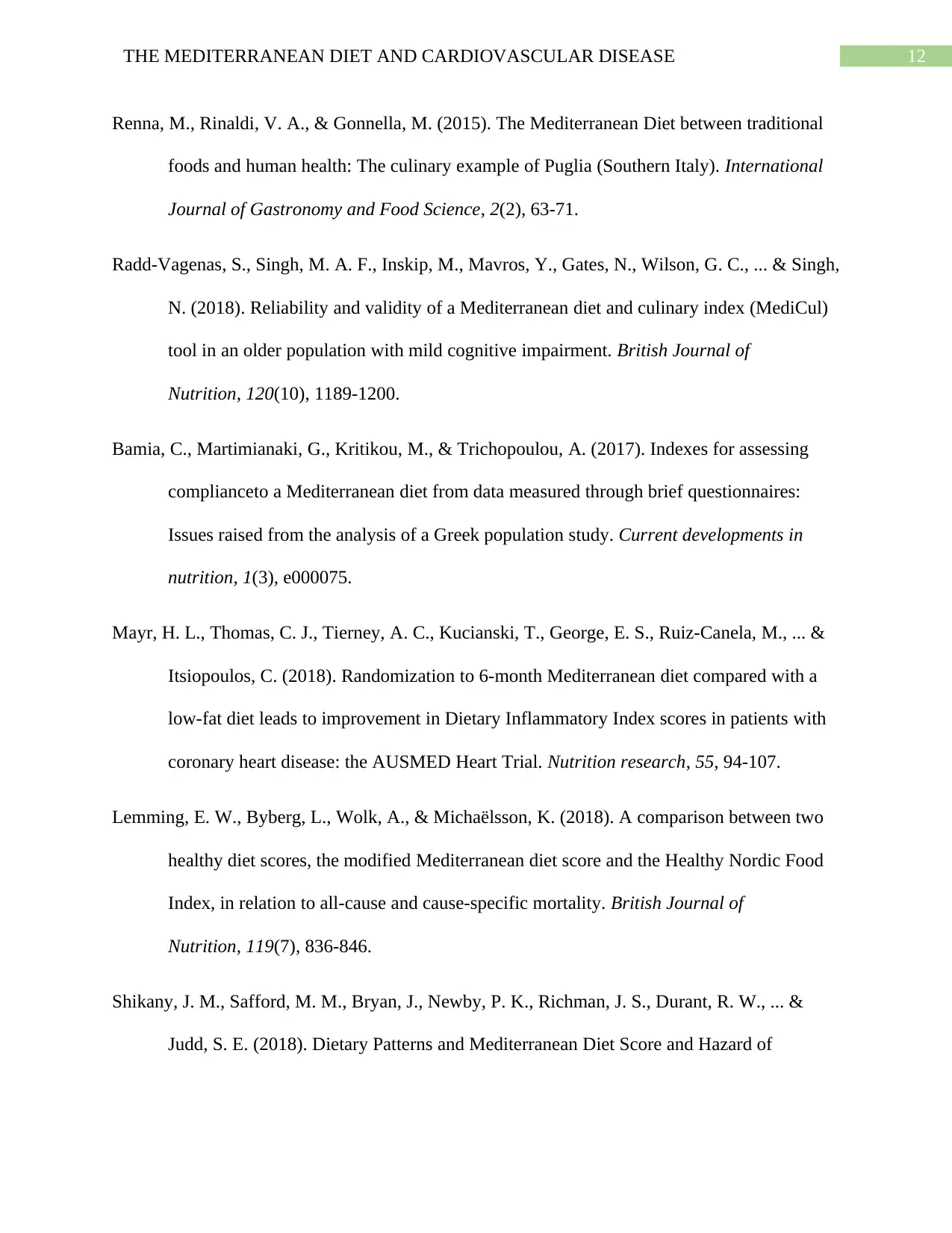
12THE MEDITERRANEAN DIET AND CARDIOVASCULAR DISEASE
Renna, M., Rinaldi, V. A., & Gonnella, M. (2015). The Mediterranean Diet between traditional
foods and human health: The culinary example of Puglia (Southern Italy). International
Journal of Gastronomy and Food Science, 2(2), 63-71.
Radd-Vagenas, S., Singh, M. A. F., Inskip, M., Mavros, Y., Gates, N., Wilson, G. C., ... & Singh,
N. (2018). Reliability and validity of a Mediterranean diet and culinary index (MediCul)
tool in an older population with mild cognitive impairment. British Journal of
Nutrition, 120(10), 1189-1200.
Bamia, C., Martimianaki, G., Kritikou, M., & Trichopoulou, A. (2017). Indexes for assessing
complianceto a Mediterranean diet from data measured through brief questionnaires:
Issues raised from the analysis of a Greek population study. Current developments in
nutrition, 1(3), e000075.
Mayr, H. L., Thomas, C. J., Tierney, A. C., Kucianski, T., George, E. S., Ruiz-Canela, M., ... &
Itsiopoulos, C. (2018). Randomization to 6-month Mediterranean diet compared with a
low-fat diet leads to improvement in Dietary Inflammatory Index scores in patients with
coronary heart disease: the AUSMED Heart Trial. Nutrition research, 55, 94-107.
Lemming, E. W., Byberg, L., Wolk, A., & Michaëlsson, K. (2018). A comparison between two
healthy diet scores, the modified Mediterranean diet score and the Healthy Nordic Food
Index, in relation to all-cause and cause-specific mortality. British Journal of
Nutrition, 119(7), 836-846.
Shikany, J. M., Safford, M. M., Bryan, J., Newby, P. K., Richman, J. S., Durant, R. W., ... &
Judd, S. E. (2018). Dietary Patterns and Mediterranean Diet Score and Hazard of
Renna, M., Rinaldi, V. A., & Gonnella, M. (2015). The Mediterranean Diet between traditional
foods and human health: The culinary example of Puglia (Southern Italy). International
Journal of Gastronomy and Food Science, 2(2), 63-71.
Radd-Vagenas, S., Singh, M. A. F., Inskip, M., Mavros, Y., Gates, N., Wilson, G. C., ... & Singh,
N. (2018). Reliability and validity of a Mediterranean diet and culinary index (MediCul)
tool in an older population with mild cognitive impairment. British Journal of
Nutrition, 120(10), 1189-1200.
Bamia, C., Martimianaki, G., Kritikou, M., & Trichopoulou, A. (2017). Indexes for assessing
complianceto a Mediterranean diet from data measured through brief questionnaires:
Issues raised from the analysis of a Greek population study. Current developments in
nutrition, 1(3), e000075.
Mayr, H. L., Thomas, C. J., Tierney, A. C., Kucianski, T., George, E. S., Ruiz-Canela, M., ... &
Itsiopoulos, C. (2018). Randomization to 6-month Mediterranean diet compared with a
low-fat diet leads to improvement in Dietary Inflammatory Index scores in patients with
coronary heart disease: the AUSMED Heart Trial. Nutrition research, 55, 94-107.
Lemming, E. W., Byberg, L., Wolk, A., & Michaëlsson, K. (2018). A comparison between two
healthy diet scores, the modified Mediterranean diet score and the Healthy Nordic Food
Index, in relation to all-cause and cause-specific mortality. British Journal of
Nutrition, 119(7), 836-846.
Shikany, J. M., Safford, M. M., Bryan, J., Newby, P. K., Richman, J. S., Durant, R. W., ... &
Judd, S. E. (2018). Dietary Patterns and Mediterranean Diet Score and Hazard of
Paraphrase This Document
Need a fresh take? Get an instant paraphrase of this document with our AI Paraphraser
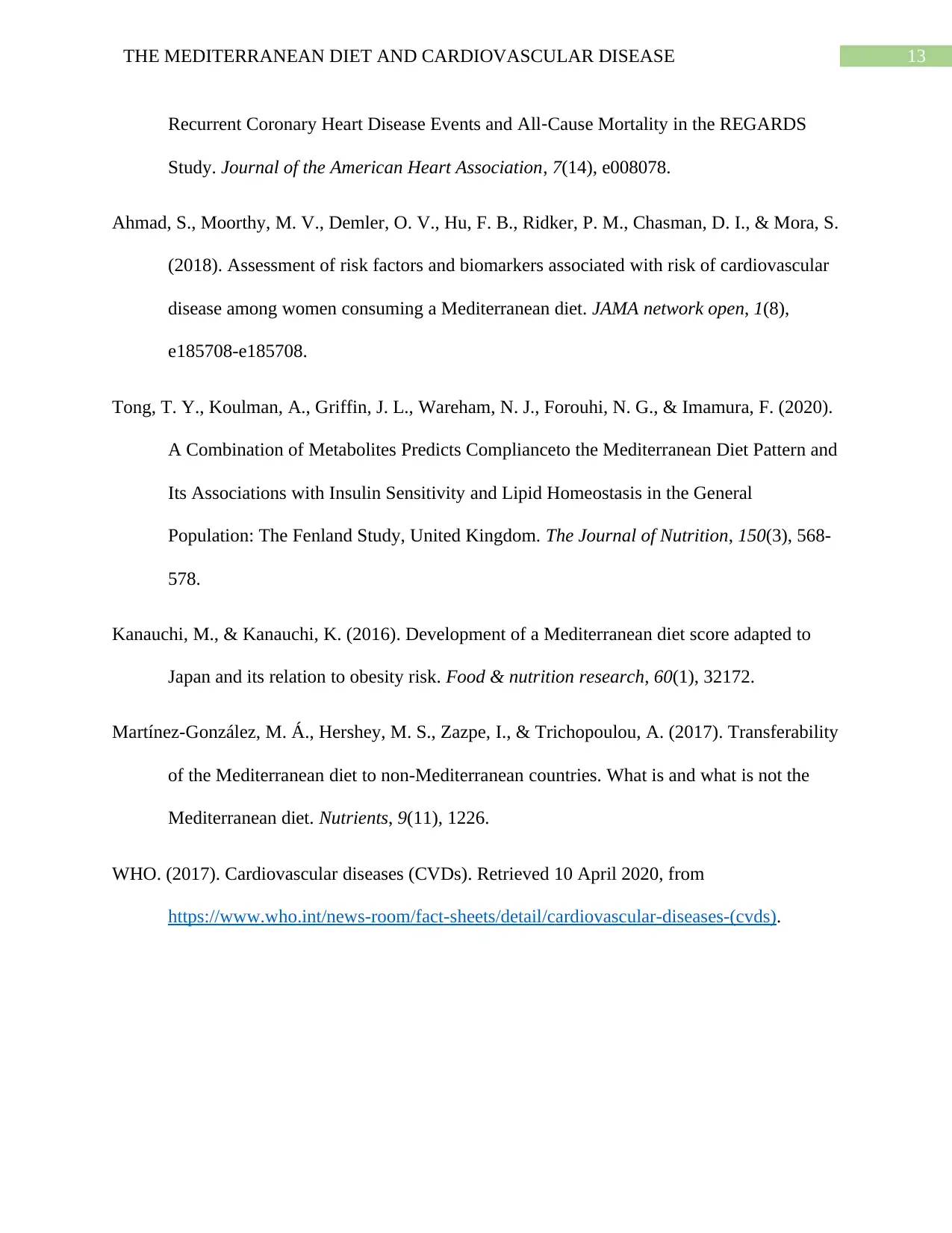
13THE MEDITERRANEAN DIET AND CARDIOVASCULAR DISEASE
Recurrent Coronary Heart Disease Events and All‐Cause Mortality in the REGARDS
Study. Journal of the American Heart Association, 7(14), e008078.
Ahmad, S., Moorthy, M. V., Demler, O. V., Hu, F. B., Ridker, P. M., Chasman, D. I., & Mora, S.
(2018). Assessment of risk factors and biomarkers associated with risk of cardiovascular
disease among women consuming a Mediterranean diet. JAMA network open, 1(8),
e185708-e185708.
Tong, T. Y., Koulman, A., Griffin, J. L., Wareham, N. J., Forouhi, N. G., & Imamura, F. (2020).
A Combination of Metabolites Predicts Complianceto the Mediterranean Diet Pattern and
Its Associations with Insulin Sensitivity and Lipid Homeostasis in the General
Population: The Fenland Study, United Kingdom. The Journal of Nutrition, 150(3), 568-
578.
Kanauchi, M., & Kanauchi, K. (2016). Development of a Mediterranean diet score adapted to
Japan and its relation to obesity risk. Food & nutrition research, 60(1), 32172.
Martínez-González, M. Á., Hershey, M. S., Zazpe, I., & Trichopoulou, A. (2017). Transferability
of the Mediterranean diet to non-Mediterranean countries. What is and what is not the
Mediterranean diet. Nutrients, 9(11), 1226.
WHO. (2017). Cardiovascular diseases (CVDs). Retrieved 10 April 2020, from
https://www.who.int/news-room/fact-sheets/detail/cardiovascular-diseases-(cvds).
Recurrent Coronary Heart Disease Events and All‐Cause Mortality in the REGARDS
Study. Journal of the American Heart Association, 7(14), e008078.
Ahmad, S., Moorthy, M. V., Demler, O. V., Hu, F. B., Ridker, P. M., Chasman, D. I., & Mora, S.
(2018). Assessment of risk factors and biomarkers associated with risk of cardiovascular
disease among women consuming a Mediterranean diet. JAMA network open, 1(8),
e185708-e185708.
Tong, T. Y., Koulman, A., Griffin, J. L., Wareham, N. J., Forouhi, N. G., & Imamura, F. (2020).
A Combination of Metabolites Predicts Complianceto the Mediterranean Diet Pattern and
Its Associations with Insulin Sensitivity and Lipid Homeostasis in the General
Population: The Fenland Study, United Kingdom. The Journal of Nutrition, 150(3), 568-
578.
Kanauchi, M., & Kanauchi, K. (2016). Development of a Mediterranean diet score adapted to
Japan and its relation to obesity risk. Food & nutrition research, 60(1), 32172.
Martínez-González, M. Á., Hershey, M. S., Zazpe, I., & Trichopoulou, A. (2017). Transferability
of the Mediterranean diet to non-Mediterranean countries. What is and what is not the
Mediterranean diet. Nutrients, 9(11), 1226.
WHO. (2017). Cardiovascular diseases (CVDs). Retrieved 10 April 2020, from
https://www.who.int/news-room/fact-sheets/detail/cardiovascular-diseases-(cvds).
1 out of 14
Related Documents
Your All-in-One AI-Powered Toolkit for Academic Success.
+13062052269
info@desklib.com
Available 24*7 on WhatsApp / Email
![[object Object]](/_next/static/media/star-bottom.7253800d.svg)
Unlock your academic potential
© 2024 | Zucol Services PVT LTD | All rights reserved.





